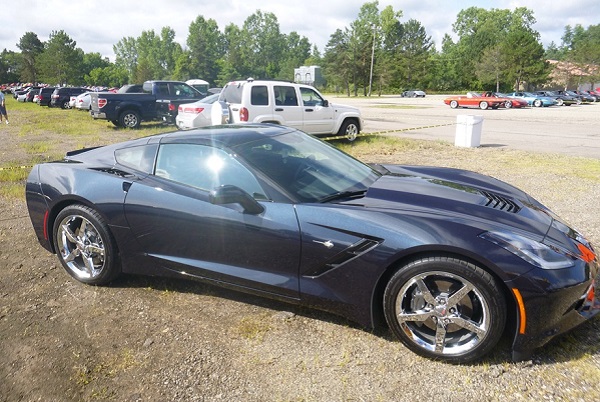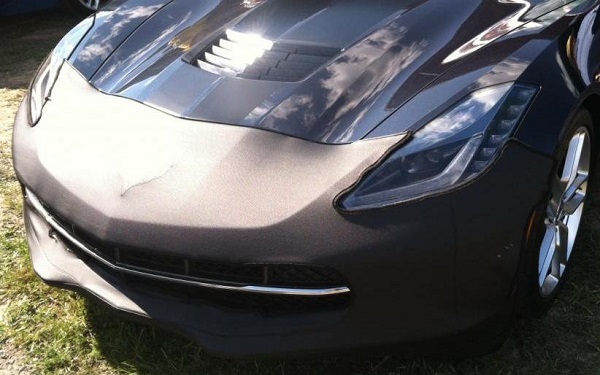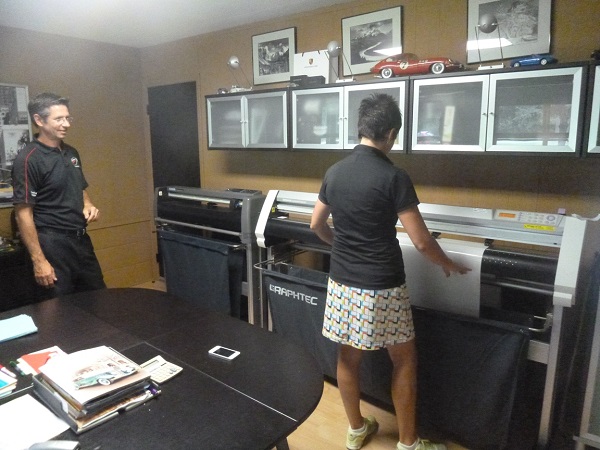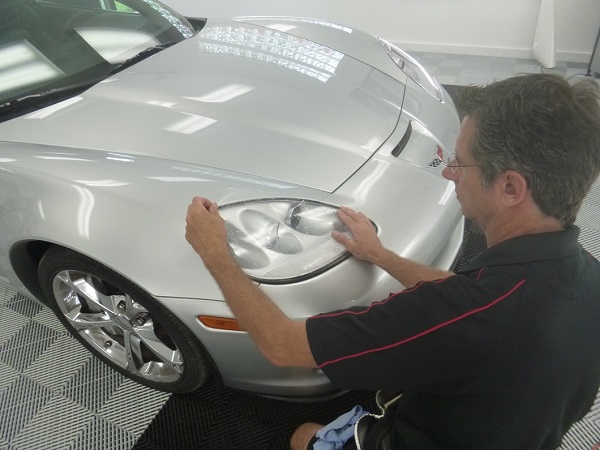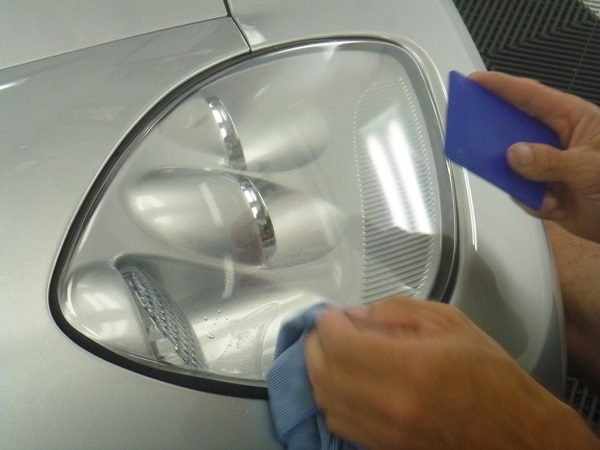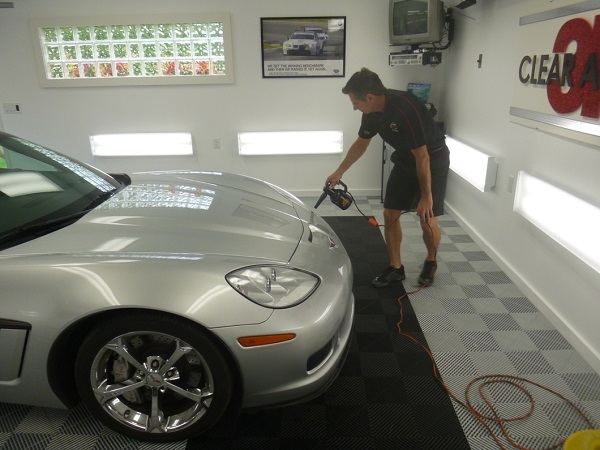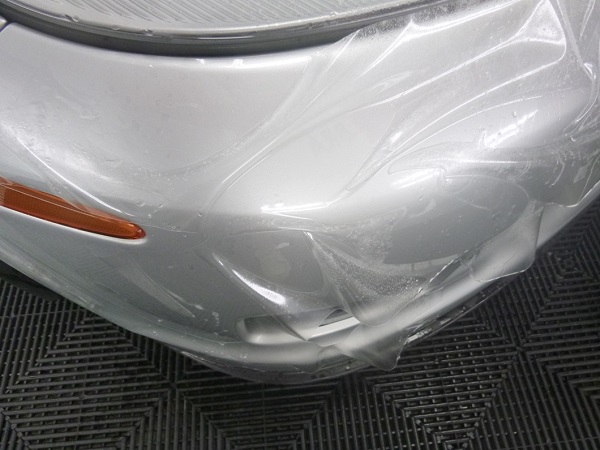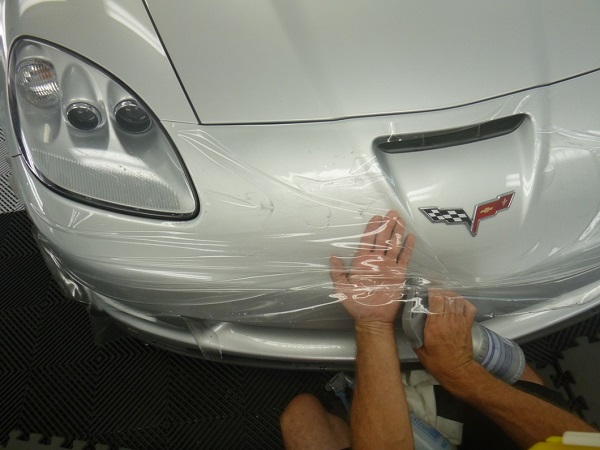Avoiding Paint Chips
It began over a year ago as you viewed speculative renderings of the upcoming C7 Corvette. Maybe a little too early to get your hopes up but you liked what you saw and wondered how closely the drawings resembled the actual car. It seemed like 1-13-13 was never going to arrive but eventually it did and you knew instantly that the wait had been worthwhile. Finally, several months later, the ordering guide was released and you were at the dealership writing your deposit check to reserve the car you’d dreamed of. And now your Night Race Blue C7 coupe is just a few days away from delivery.
It has been over a year since you began imagining, fantasizing about this car. It wasn’t inexpensive and cost the better part of your annual salary but you knew you were going to own this car for a long time, maybe a lifetime. You put a lot of time and effort in choosing the options suited just for you. This is a driver’s car and you planned on doing a lot of that behind the leather-wrapped steering wheel. This car, your car, was not going to be a garage queen. No way. This car was going to be driven. Anticipation was almost on overload as delivery day approached.
Then the night before delivery, you awaken from a nightmare in a cold sweat. Worse than torture and more than any car enthusiast could endure, what follows are the gruesome details of the terror.
Everything at the dealership went as planned. The elegant Night Race Blue with Gray leather had been impeccably prepared for delivery and, not missing a marketing opportunity, the dealership had the car parked in front of the entrance to entice other buyers into the show room. The metallic flake in the dark blue paint looked almost like diamond dust glistening in the late morning sun. After almost an hour and a half briefing covering the car and its features, papers were signed and both fobs were handed to you.
You settle into the leather bucket seat, much improved from earlier generation Corvette seats. The wonderful aroma of the new interior fills the air as you take it all in for a moment, hands on the wheel, savoring the moment that you knew would be remembered forever. Your right hand checks the shifter to see that it is not in gear then you depress the clutch and push the start button.
As you get the revs up the dual mode exhaust kicks in and the sweet sound of the engine begins its serenade as you ease into first gear and gingerly pull out of the dealership. You debate which route to take for the five mile trip home. Though you knew you were not going to push the car too hard initially, you can’t stand the thought of driving this car in heavy street traffic the entire way home. You decide to take the interstate even though it would be a few miles longer but would not be “stop and go” and it would give you a chance to get a feel for the car above 70 MPH.
Merging onto the freeway, you check your blind spots then carefully maneuver the car through the two middle lanes until the new C7 reaches the mostly clear left lane. So you work through some gear changes to experience the downshift rev-matching feature and notice that along with this impressive technology, the dual mode exhaust emits a wonderful burble during each downshift. Being so engrossed in the car you are surprised at how quickly you caught up with some left lane traffic.
The C7 comes up behind a 4 x 4, the lower part covered in dried mud and you back off not wanting to get too close to the truck. You can’t get over since there is a pretty girl in a Chevy Cruze giving you a thumbs up as she paces your hemmed-in C7. You quickly smile and wave. As you back off the throttle and downshift from seventh to fifth the glistening Night Race Blue Corvette slows and falls back to about fifty feet behind the truck and the pretty blonde in the Cruze moves on ahead. You glance at your mirrors so you can move over and get out from behind the bottle-necking truck.
Suddenly, before being able to change lanes, you are startled by the sound of a distinct snap. Like the sound of a breaking twig, you know immediately it is a small stone ricocheting off fiberglass. You feel your stomach sink and your face flushes as you take your foot off the throttle instinctively and assess the situation. Not being completely familiar with the new car you are not sure if the sound came from inside the wheel well or the body of the car. You pray it is the former. You quickly check your mirrors again, put on your right turn signal and seeing no cars impeding your move, immediately move back to the center lane and then the right lane to get well away from the truck and any other flying debris. You move to the “Exit Only” lane and wish you hadn’t taken the freeway because of the truck.
When you get home you begin to closely inspect the perfect impeccable paint job for any evidence of a stone chip, still praying it was only a pebble thrown by your own Michelin Pilot Sports inside the wheel well and well hidden. But you don’t have to inspect the car too closely, as you look at the sharp lines and beautiful front of your Stingray there it is. Right on the front of the hood about half way between the new C7 insignia and the black hood vent, a chip, approximately a quarter inch, which had chipped away the paint to reveal the primer below. Your car has not only been deflowered it has been ravaged, the pristine paint ruined. Uncontrollably, you utter a low guttural moan which turns to a raging scream which wakes you from the horrible nightmare in a pool of sweat.
After regaining composure you begin to replay the nightmare in your mind struggling to think of a way to prevent the nightmare from materializing. You are experienced enough to realize that despite the claims of paint chip repair products and traditional touch up paint, that it is almost impossible to repair paint chips without a costly professional repaint that virtually repaints and blends the paint into the surrounding original color. But even with professional attention certain metallic paint colors are almost impossible to perfectly match without a very slight shade difference and Night Race Blue is one of the more difficult to match.
You consider the options and know that for the sake of one quarter inch chip you probably wouldn’t take the chance of a mismatch and would just put some touch up paint on the chip and try to hide the pebble sized flaw as best you could. But you know that the chip can’t be hidden completely, not without professional attention. Realistically you might consider a professional repair after the car inevitably gets “stoned” a few more times, a distressing and imperfect solution.
Just considering the possibilities is disconcerting and though there is no perfect solution for protecting your ride whenever it’s out, there are options to consider. Even though most of the remedies have been around for quite some time, improvements and some relatively new products require an updated assessment and reevaluation of what’s available and what is the best choice for your particular situation.
A step above doing nothing is waxing your car, which helps protect paint from tiny insects as long as the kamikaze bugs are removed soon after they commit suicide on the front fascia of your car. But besides providing protection from insects, waxing does little to defend the paint from blowing sand or flying stones. If this is the route you choose you will need to resign yourself to periodic professional paint repair with hopes of being able to exactly match your paint after a few years of minor sun fading, if you want your car to have a five foot or closer surface finish. Each year over 10% of American car owners spend money making minor repairs (mostly paint) for scratches, scrapes and rock chips. If that isn’t your solution for rock chips then you obviously need to take a more aggressive approach to paint protection and you need to evaluate other available options.
There are really only two major choices for consideration to protect the paint on your car. And both have their own positive and negative aspects to consider. The first and oldest is the tailored car bra, which can be installed and removed as often as you’d like. The second, a newer solution, though it has been widely available for over two decades, is a semi-permanent, clear, eight mil (.008) polyurethane film applied to the car finish. This is usually called a “clear bra” and there are various manufacturers of the film. Let’s take a look at the two options to determine best solution for your car.
The removable padded front fascia and mirror protectors have been around for decades and are made of everything from a thin nylon to a heavier vinyl or leather and are frequently padded. The more expensive masks can even come in the color of your car under the premise of camouflaging the appearance and appear less offensive. But the effort is futile as you cannot hide the bulky cumbersome masks. Because they are thicker, they offer superior protection against rocks and stones and do an excellent job at deflecting road debris. Masks require the owner to install them when the car is being driven and removed when parked for any length of time so that condensation formed under the bra will not damage the paint or cause the mask to deteriorate or potentially become moldy. Though mold is rare, it has happened with inexpensive vinyl masks particularly.
I have found one of the best uses of the “mask” is for extended trips used as a temporary safeguard for driving your car to and from car shows, particularly if you compete for trophies. They offer good protection while driving and can be removed for showing the car. One of the negatives of using the mask for extended trips is that in most Corvettes or exotic sports cars luggage space is limited and the bulky padded mask takes up space when not being used on the car. And for daily use, when most of us put on the majority of miles and subsequently are at the greatest risk of getting “stoned,” the installation and removal of the mask is time consuming. It also seems counterproductive to spend big bucks buying a stylish car like a Corvette and then hiding the gorgeous paint you’d like to protect with an unsightly bra.
Another deficiency of the car bra is that it doesn’t protect your headlights. Unfortunately, the clear headlight covers on one of my early C6s were unprotected and as luck would have it, one was the victim of road shrapnel. I don’t have to tell you they are not cheap to replace. Finally, the last drawback of the bra is that if your car is parked and left for any period of time it can be easily and quickly stolen. If you’ve invested in a quality bra for a Corvette or exotic sports car the stolen mask can be easily sold, so they make tantalizing targets for thieves.
As you can probably judge, except in specific applications, the car bra’s negatives outweigh the positives especially if you frequently drive your car or do not want to compromise the looks with a bulky mask. Having owned several of the masks over the years, I believe the better solution is what has become known as the “clear bra,” an 8 mil polyurethane film custom fitted and applied to almost any surface on your car, including lights. I also have some experience with this option having had it installed on my 2005 C6 coupe from the time it was new. There are several positives and few negatives about this method of protecting your paint if it is done correctly. The film is virtually invisible, maintenance free, doesn’t harm the paint, and can be removed. After installation you can wash and wax the car as normal. Most professional applications come with a five or ten year guarantee.
Though there are few negatives to the clear bra paint protection choice, some users have complained that after time dirt can get under the edges and discolor. In many of those cases it was due to faulty installation or the owner not washing the car for long periods of time. The clear bra on my 2005 looked as good when I sold the car in the spring of 2013, after eight years, as it did when it was delivered. The only problem I encountered, as mentioned, was the cracked headlight due to not having had the film applied to my headlight covers. But I had no rock chips on my paint where the clear bra had been applied.
Interestingly, buyers of high priced European sports cars and exotics are the biggest users of the clear bra product. Most Mercedes, Porsche, BMW and Ferrari dealers recommend the application and a large number of buyers have it installed before taking delivery. Most dealer applications are subcontracted to professional installers due to the difficulty of the installation and often the price is added on to the final delivered price of the car and can even be built into the loan if desired.
3M® is the largest supplier of the film which comes in roll form, precut for specific applications, and as a spray on do-it-yourself product. Recently there have been several marketing efforts for the do-it-yourself spray on paint protection film, offering an alternative to the cut and applied film. If you have the skill, both versions can be done by the car owner and kits are available precut for almost every car but before attempting this make sure you understand everything involved in the application procedure. More than a few kits have been ordered and quickly discarded due to the difficulty of the installation procedure and requirements. The fact that most dealerships subcontract this to third parties gives you an idea of the difficulty involved in achieving a flawless application.
To clarify, many car owners may think that they can save a lot of money by doing the installation themselves whether using spray-on film or the precut kits. Typically a quality precut kit will run $150 to $250. Beware of kits offered at unrealistically low prices. Often these kits are old, have defects or were incorrectly cut and as a result simply will not work. Even attempting the installation with a quality kit, it is extremely difficult to end up with an almost invisible application.
On my new Grand Sport, before opting to have the clear bra professionally installed, I wanted to check out all options including the recently heavily advertised spray-on product. Additionally, I debated whether I could save money by doing either the spray-on film or precut kit myself with the help of my son, an engineer. The first step was to go to the forums and ask advice from members that had used the spray-on product or had tried to install the precut pattern film as a project. Sadly, I did not get one positive response in regards to the spray-on product and only one positive about applying the film personally, though that person said he’d never try it again. Most respondents said that doing it correctly requires a dust free environment similar to a spray booth and even then some said that they had difficulty getting it to adhere properly, particularly around the edges. Still others had some problems with clouding, likely due to improper surface preparation or installation.
But I was not going to be deterred; I bought a can of the spray-on product and attempted to install it on the hood of my riding mower. Let’s just say the results were not something I wanted to put on my new Corvette. The best analogy is that the spray-on method is like attempting to paint part of your car with a can of off-the-rack spray paint and expecting it to match the rest of the paint. It can be done if you have the right environment and skill level but if you don’t, it’s not recommended. One forum member summed it up best when he said if you use the spray-on film you virtually need a paint booth, the skill of a painter and the patience of a cadaver to do it right and even then getting it to adhere at the edges without wrinkles is a crap shoot. Needless to say, following the attempt on the mower and possessing none of the advised pre-requisites I eliminated the spray-on option for the Vette.
The next option was to look into installation of a pre-cut kit. But before attempting this and dropping almost $300 I wanted to observe an installation to see what was involved. It did not take me long to realize that this requires more than a little skill especially if you are installing the film on anything other than a flat surface. On a car with angles and curves it’s very difficult and time consuming. It is tantamount to installing wallpaper on a football without wrinkles or creases. So attempting the pre-cut method was also canned. That left the final option of a professional installation.
Though I had hoped to save money by doing it myself, I realized that the odds of achieving a proper installation on my new Grand Sport convertible were about as good as me driving in the 24 Hours of Le Mans! So the next step was to find an outstanding installer. Simple? Not quite. I got prices ranging from $500 to $1600 from six different installers to do my front fascia to just past the front scoop, my headlight covers (once burned, twice shy), and my mirrors. I checked with other Corvette owners who had the work done in my area, local dealerships, and with some Porsche and Ferrari owners. I also checked with the local exotic car dealership, thinking that a high-end dealership would not subcontract work to anyone who was not thoroughly qualified (have you checked the price of a Lamborghini or Ferrari recently?).
I decided to use Larry Millen, owner of Paint Protection Plus and the installer most recommended. Since he wasn’t one of the first installers I investigated I called him for an estimate. Surprisingly, his estimate was squarely in the middle but from the date he gave me to perform the installation, almost three weeks out, he was clearly the busiest. I had expected his prices to be higher since he had been so highly recommended. Millen employs two other full time installers who Millen personally trained for over a year before allowing them to do an application alone. The owner personally handles the most difficult jobs which encompass all exotic and most Corvette installations. The two employees usually do most of the off-site work in dealerships that Millen has personally approved for cleanliness and lighting. Millen’s wife, Jennifer, takes care of the office, the plotters and the computers needed to run the company which handles over a thousand cars a year in the “Motor City.”
So you have a comparison, his estimates are approximately as follows:
Front Fascia $800 – $1000
Front Fascia and Full Hood $1200 to $1400
Lights $100
Mirrors $25 each
Lower Sides $500 to $800
Full Doors $500 to $800 each
Two days prior to my scheduled installation I called and asked if I could observe the installation and ask him some questions about the business. He agreed but requested silence during the more intricate and detailed parts of the installation as he needed his full concentration to ensure a superior application of the film.
Larry and Jennifer greeted me when I arrived at their immaculate, well-lit and dust-free facility constructed specifically for the application of the protective film. He’s been doing clear bra installations for more than a decade. However, the business requires more than just a well-lit, dust-free garage. Some of the most important tools are the computer and giant cutting machines called plotters, which cut the large rolls of film into custom patterns tailored for each installation.
The car information is fed to the plotters through a computer program and the patterns are cut from various sized rolls of the 3M® film. The patterns are downloaded from Xpel Technologies®, an online resource that Millen’s company subscribes to insuring he has the widest selection of updated and accurate patterns. Furthermore, a costly inventory of film in various sizes must be stocked to insure the pattern is cut from fresh film. Larry cautioned against some precut patterns that have been in stock for years because a pattern cut years before from inferior film often “clouds” after installation and may begin to lift off the cars surface. One thing to look for when choosing an installer is to find one that cuts patterns from fresh stock on a daily basis as this will minimize problems.
The more I observed the equipment, the facility and the professionalism exhibited by Larry and Jennifer, the more confident I became that I had made the right choice in deciding to have the job done professionally and in my choice of installers. Two lessons had been learned in the brief time I had been there: first, beware of any installer that gives you an unrealistically low estimate because to do the job properly with fresh, quality materials involves substantial fixed costs. Secondly, the installer that can do the job the next day probably won’t be in business in a month.
The garage Millen has built to accommodate the installation is lit not only from the ceiling but completely along the lower half to ensure that the film is free of any creases and air bubbles. Larry thoroughly cleans the areas to be protected as the first part of the installation process. Caution is taken to remove anything adhering to the paint. After drying the car, Larry pre-fits the cut pieces to make sure the pattern is not only correct but also to determine the sequencing of installing the individual pieces.
Larry then selects the first piece to install and uses soapy water under the film to help position it correctly as he tightly positions and stretches it ensuring it properly adheres. Watching him work on what I thought would be a simple installation on the headlight cover, I was surprised by the time it took to get it positioned just right. But when finished, the film was virtually imperceptible. I couldn’t imagine the skill and expertise it would take to do the complicated front fascia. The more I observed his skill the more I realized that I had made the right decision in choosing to have the clear bra professionally installed.
Recognizing the concentration necessary to position and work each piece of the pattern correctly, I refrained from speaking while he worked. But during the transition periods Larry explained more about the business and confirmed some of what I had already learned from my research: that domestic dealerships have not bought into the clear bra paint protection programs as European dealers have due to the costs of the application relative to the price of the car. He said he clearly understood why a buyer of a car costing under $30K may not want to spend the $1K to have a quality installation. And during another break he showed me two cars he had installed the clear bra several years before. One was a red 2008 Toyota Yaris which had been through well over a hundred car washings since it was installed five years ago. The other was the application he did on his wife’s seven-year-old white minivan. Both applications still looked fresh, the edges still intact with no dirt or discoloration.
Though Larry strives for a flawless installation he admits that no job is perfect but went on to state that a job should clearly free of noticeable flaws or defects. Millen said to always ask an installer for recommendations of recent and older applications and then to go check them out. Some things he says to look for are: fingerprints in the film, dirt filled edges, wrinkles, peeling, dull or cloudy film, any signs of poor workmanship or inferior product. Additionally, ask to see the facility, a dirty work space often results in an inferior installation. Another question often overlooked, especially with larger installers is exactly who will be installing the film on your car. It is not a job for someone who has not been trained for several months. Good installers can be found in almost every major city but it usually requires asking for recommendations and researching. Millen says usually the best installers don’t need to do much advertising because they usually have all the work they can handle.
Another consideration when choosing a clear bra to protect your paint is that it require minimal to no attention aside from normal washing and waxing. But Larry does recommend using a good quality car wash and to wash any bugs off as soon as possible. He said many of his clients have found that insects come off the film easier than they come off bare paint. Some things that should be avoided are harsh cleaners, bug removers, brake cleaners, or adhesive removers. Hot soapy water is the best way to wash the car. Following these guidelines you can get several years from the film.
The entire installation took about four hours and when finished it was nearly invisible. Having had the 3M® clear bra on my last Corvette, I was pleased with how well it protected the front of the car during the eight years of ownership and I expect to get the same on my Grand Sport. So if your new C7 is due to arrive, don’t lose sleep worrying about it getting stoned. Be pro-active and schedule a clear bra installation with a reputable, recommended installer.

